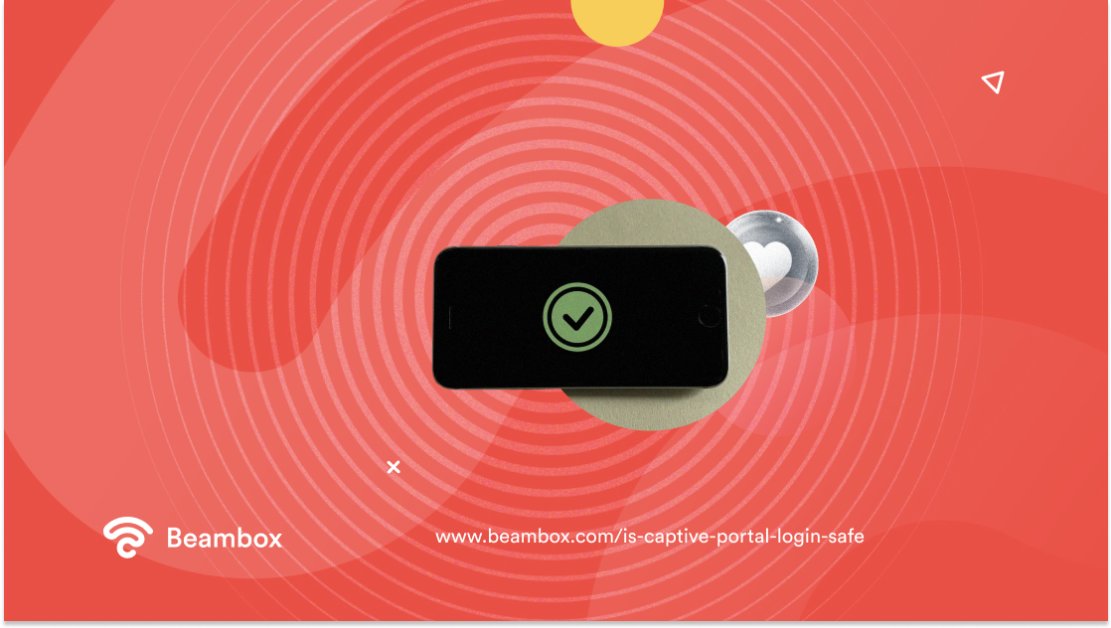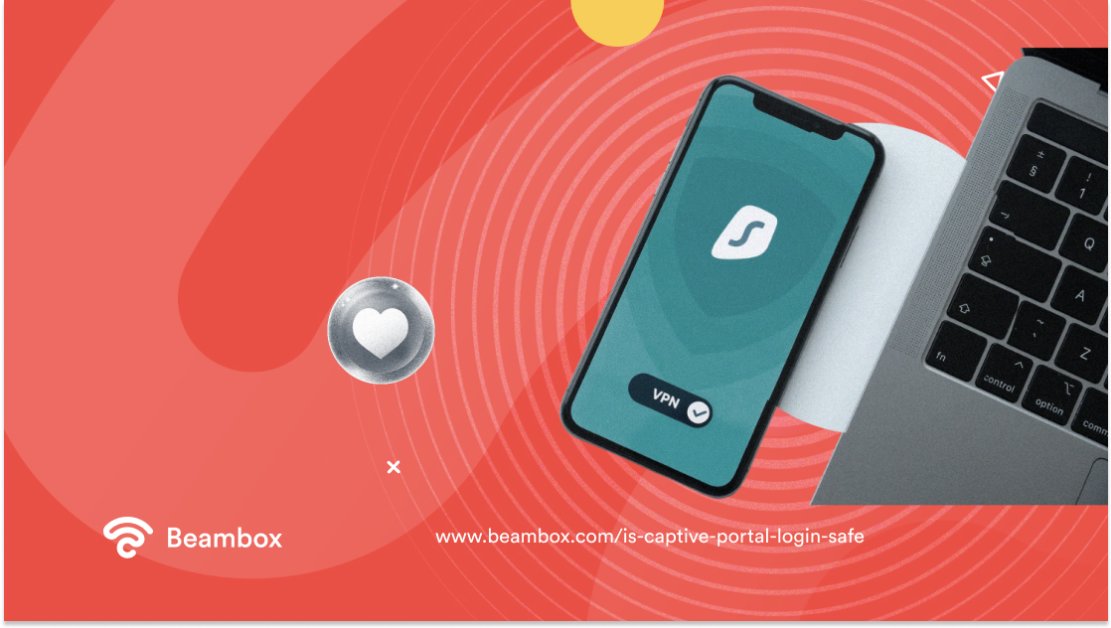Captive portals have always been a hot topic when it comes to WiFi marketing. While some businesses swear by these login pages for user authentication, others fear breaches of customer and company data. The latter group often wonders, “Is captive portal login safe?”
You’re probably a part of this group since you’re here. With hackers on the loose becoming stronger with each passing day, questioning the captive portal’s safety is justifiable.
However, it won’t be possible to take action without diving deep into the concept of captive portals. So, if you’re ready to fulfill your curiosity, let’s start!

Let’s Kick Things off With What Is a Captive Portal?
It isn’t a wise decision to learn about the security concerns before understanding what a captive portal is. After all, you don’t want to be stuck with incomplete information that isn’t much use to reduce the security risks. Therefore, let’s begin with the definition.
A captive portal is a login page that businesses use to authenticate users requesting access to their WiFi network. For example, coffee shops often limit the use of the WiFi only to paying guests. They manage authentications through captive portals.
It’s a way of blocking unwanted devices and getting useful customer information, such as email, in exchange for network access. Now, let’s see how a captive portal works.
The process starts when customers try to log in to your guest network. Instead of getting direct access, their device’s web browser redirects them to a temporary login page.
Now, what they see on this page and what information they need to enter is up to you.
Firstly, you can (and should) promote your products and services here along with your branding. Everyone who wants to connect to the internet through your wireless network will have to visit this page. Therefore, it’ll be hard to ignore the promotional messages there.
Secondly, you can ask for the customer’s phone number, email address, name, location, etc. Not only will you keep unauthorized people at bay, but you’ll also be able to personalize your messaging.
Once customers enter their data in the authentication server, you can store it in your CRM. The captive portal authorization process verifies the user credentials and grants them access to the broader WiFi network.
What Mechanisms Does a Captive Portal Use to Block Devices?
Since you learned that a captive portal blocks unauthorized access, you must be curious about the mechanisms it uses. Well, the short answer is it uses firewall rules. However, there’s a bigger picture at play here because different types of rules exist.
Blocking devices according to MAC address, IP address, time limit, user limit, or protocol is your choice. But to do that, you must be familiar with each type. Otherwise, you won’t be able to fulfill your blocking needs correctly.
You can use the MAC address rule if you want to prevent authorized customers from sharing their passwords.
While the credentials will remain the same, the MAC address for each device is different. So once customers authorize themselves through the captive portal, you can store the MAC addresses in the approved database. If the MAC address trying to connect without authorization first isn’t in the database, the firewall rule will block it.
Another approach is to block according to IP addresses. However, IP addresses keep changing, so this rule isn’t foolproof.
Next, we have user limit rules that allow you to control the number of users on your guest network. You don’t want to overburden the network and ruin the experience for other customers.
The time limit rule is similar to the last one. Sometimes, customers take unfair advantage of your guest network and keep using it for long durations.
This can make the speeds slow and create a hindrance for other users.
Therefore, set time-limiting rules to disconnect devices crossing the time threshold automatically. Lastly, you can also block devices with bad security by using protocol rules.
However, setting up all these rules by yourself is complex and requires technical knowledge. That’s why WiFi marketing software comes in handy for most businesses.

Does Setting up a Captive Portal Require You To Be a Computer Whiz?
Now you know the core of a splash page for authentication. Let’s move then to the captive portal flow for setting it up. The good news is you don’t have to be a computer whiz to set up a basic captive portal.
There are various apps and websites that can assist you with this process. However, free resources can’t cut it as your business grows. You cannot customize the captive portal. And half of its goodness slips away if you can’t display promotional messages.
Therefore, as your business expands, opt for paid solutions that let you customize your splash page. Remember that you will need some technical knowledge or guidance to set these up and customize them. For now, let’s look at the general basic setup flow.
- Open the access point’s setup menu and look for the “Captive Portal” or “Global Configuration” heading.
- In the portal settings, customize the name, password protection, and redirection, for example, to an existing webpage.
- In the splash page screen or web customization options, choose what users will see when they attempt to connect. From custom logos and backgrounds to login instructions and terms of use, the options are endless.
- Associate the portal with a wireless radio band and service set identifier (SSID.)
- Test the captive portal setup by connecting to your hotspot with a WiFi device.
Authorization Aside, Is Captive Portal Login Safe?
To field the question, “Is captive portal login safe,” let’s read between the lines of its working.
Secure websites with the https protocol keep threats away by encrypting the content. However, a captive portal defies this and intercepts the traffic. As a result, the browser warns the user that this site isn’t safe.
It’s common knowledge that public WiFi networks are less secure than private ones. Hence, most people ignore this warning. That’s okay as long as the captive portal is causing this warning. However, due to such instances, people ignore all warnings even when the websites are a threat.
But what if the device is using a VPN? Well, it won’t make much difference since VPNs need to disconnect for a captive portal to work. You and your users’ data is at risk during that tiny window.
Moreover, some hackers show fake captive portals to get user data and inject malicious codes into the device. However, the safety of a connection is mostly down to the business and the awareness of the user.
What Can Businesses Do To Make These Login Pages Safer?
You would think that the advancing technology would have solved this issue by now. However, businesses use different networks and systems for initiating a captive portal. Therefore, experts haven’t been able to create an automated, coherent system for a secure authentication process.
However, it’s not the end of the road. You can still make some efforts to reduce this problem.
Firstly, the captive portal should reject connection requests from questionable and unsafe websites. This way, the user will see “Connection refused” instead of seeing “site not secure,” solving the problem of warning neglect.
Secondly, use the WPA2 Enterprise model for your captive portal. Each user will have a different username and password, adding a layer of security. Not only will this keep threats at bay, but it will also make the authorization process smoother.
Also, consider general security practices:

These Companies Give Solutions for Different Captive Portal Security Issues
In short, the answer to “Is captive portal login safe?” has no straightforward answer. It is down to the user and the measures a business takes to protect its connection. Whether it is wired networks or WiFi, the human factor defines the safety of an internet connection.
Therefore, consider using tools that help you keep your WiFi safe even if you have no IT knowledge.
Beambox is a WiFi marketing solution that allows you to create guest networks and secure your WiFi. Moreover, you can set up rules for optimizing the internet experience for your customers.
With Beambox, you can also automate marketing campaigns and grow your online reputation on autopilot. Start your free trial today!
Get Started With Free WiFi Marketing
Beambox helps businesses like yours grow with data capture, marketing automation and reputation management.
Sign up for 30 days free